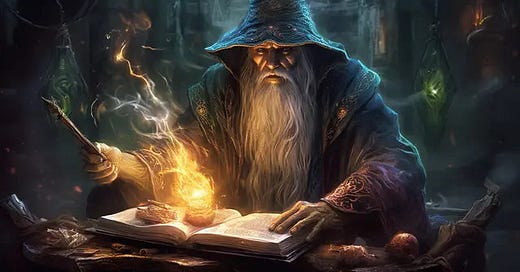The Symbolism of Wizards and Staffs (And Wands)
And How It Connects to Our (Post) Modern Moment 🧙♂️
Last night, someone in The Symbolic World group asked about the symbolism of wizards and their staffs. I shared a thought that seemed worth expanding into a full post, as it offers a way to think about the deeper meaning behind wizards and their staffs. Wizards and their staffs (or wands) can be seen as symbols of the ongoing struggle between time and space for manifestation. This perspective helps illuminate the underlying dynamics at play whenever these archetypal figures appear in stories and myths.
The staff or wand functions much like a tree, a potent symbol of space in many cultures, including Christian tradition. Trees represent a vertical connection between heaven and earth, standing as pillars that join the spiritual realm above with the material world below. In Christian thought, this is evident in the image of the Tree of Life, which symbolizes the ordered, structured cosmos where heaven and earth are aligned in harmony. Moses’ staff offers a vivid biblical example—when he parts the Red Sea, it’s as if the staff itself imposes divine order on chaotic waters, creating dry land where stability and space can emerge.
Wizards, on the other hand, can be seen as symbols of time. They are often depicted as manipulators of creation, bending or shaping the natural order through magic, which is frequently portrayed as a kind of deviation or distortion of divine law. In this sense, the wizard’s power is an attempt to force heaven and earth into alignment, but in a way that resists or subverts the natural harmony intended by God. This manipulation of creation symbolizes time’s tendency to introduce change, decay, and unpredictability into the ordered space of the world.
In stories where wizards overextend their powers, their staffs or wands often become fragile or break. This narrative motif can be seen as a reflection of the inevitable consequences when time’s transformative force overreaches the limits of order. For instance, when Ron Weasley’s wand in Harry Potter is damaged, it leads to all kinds of disorder, leading to chaotic and unintended consequences in his spellwork. Similarly, the breaking of Saruman’s staff in The Lord of the Rings symbolizes not only his defeat but also the collapse of the unnatural power he wielded, leading to the siege of his stronghold at Isengard. In both cases, the breaking of the staff indicates a return to the natural order, as the forced harmony collapses back in on itself.
Even the physical appearance of wizards reflects their connection to time. Characters like Saruman and Gandalf, with their long, unkempt beards and flowing robes, evoke the imagery of age and the passage of time. The beard, often associated with wisdom and maturity, also represents time’s capacity to overgrow and obscure. This brings to mind the figure of the Green Man, a symbol found in medieval Christian art, who embodies the renewal and decay of nature through the growth of foliage and vines. The Green Man’s overgrown features signify how time, left unchecked, covers and changes the landscape, just as wizards are portrayed as figures who shape and alter reality.
This is why they’re also depicted as marginal, liminal figures who are outsiders. They’re an embodiment of the margin and time.
In this way, the imagery of wizards and their staffs can be understood through a symbolic lens that aligns with traditional Christian themes. The staff, like a tree, is a symbol of space, rooted and stable, while the wizard embodies time, seeking to alter, reshape, and bend the created order. This tension reflects the broader cosmic struggle between order and chaos, stability and change.
Time and space are in constant tension, each vying for manifestation. This dynamic is vividly captured in the image of the wizard and his staff. When a wizard aligns the connection between heaven and earth with divine law—like Gandalf does—harmony prevails. In such moments, time remains at the margins, and the center is marked by order and stability. However, when the wizard tries to manipulate or force this connection against its natural order, the balance collapses. Time then rushes into the center, disrupting the established order and unleashing chaos.
This symbolism offers a lens through which to understand the current state of our world. I’ve often described the prevailing turmoil as a “dark enchantment.” Much like wizards, those in power are attempting to reshape creation, using their influence to bend reality against God’s cosmic order. As a result, the natural harmony is being disrupted, plunging the world into chaos. Time itself feels compressed, intensifying the pace of change and accelerating the disintegration of stability.
However, there is a key difference between these powers and the archetypal wizards. Wizards, at least, wield a staff—a symbol of space, structure, and the possibility of order. These figures lack even that; they are more akin to chaos magicians or necromancers, conjuring from the void without any grounding in the order of creation. Their actions push further into the realms of disorder, dismantling the framework that holds the world together.




